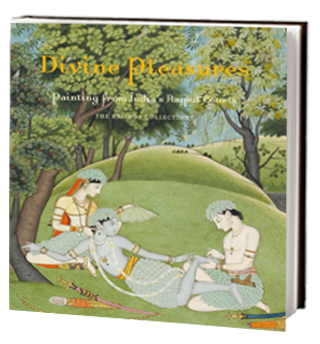
Presenting nearly 100 vibrant works, this catalogue celebrates the diverse styles and traditions of Indian painting.
Buy NowCompelling episodes from the epic and poetic literature of the Indian subcontinent dominate the nearly 100 masterful paintings—most a 2015 promised gift by Steven M. Kossak from his family's Kronos Collections—in this exhibition. Created mainly between the 16th and the early 19th century for the royal courts of Rajasthan and the Punjab Hills in northern India, the works on view are meant to move the soul and delight the eye. The collection was assembled over nearly four decades by Mr. Kossak, formerly a curator in The Met's Department of Asian Art.
Rajput court painting was mainly intended for royal delectation, to amplify—through the artistic fantasy manifest in the pictures—well-known religious, quasi-religious, and secular texts and subjects. Under the patronage of their Rajput rulers, many of the principalities of north India developed and nurtured a distinctive painting style that expressed a new way of seeking the divine through bhakti, or personal devotion.
This galaxy of stylistic expression is amply demonstrated in the exhibition through compelling examples of the Early Rajput Style; the later schools of Bikaner, Bundi, Kishangarh, Kota, and Mewar; as well as many of the small courts of the Punjab Hills: Bahu, Bahsoli, Bislalpur, Chamba, Guler, Kangra, Mandi, Mankot, and Nurpur. Many of the paintings have never before been exhibited publicly.
Accompanied by a publication
The catalogue is made possible by The Peter Jay Sharp Foundation.
The Village Beauty (detail), ca. 1785. Probably painted by the artist Fattu (active ca. 1770–1820). Illustrated folio from the dispersed "Kangra Bihari" Sat Sai (700 verses of Biharilal). India, Punjab Hills, kingdom of Kangra. Opaque watercolor, ink, and gold on paper; painting 7 3/8 x 5 3/16 in. (18.7 x 13.2 cm), page 8 1/8 x 5 7/8 in. (20.6 x 14.9 cm). Promised Gift of the Kronos Collections, 2015